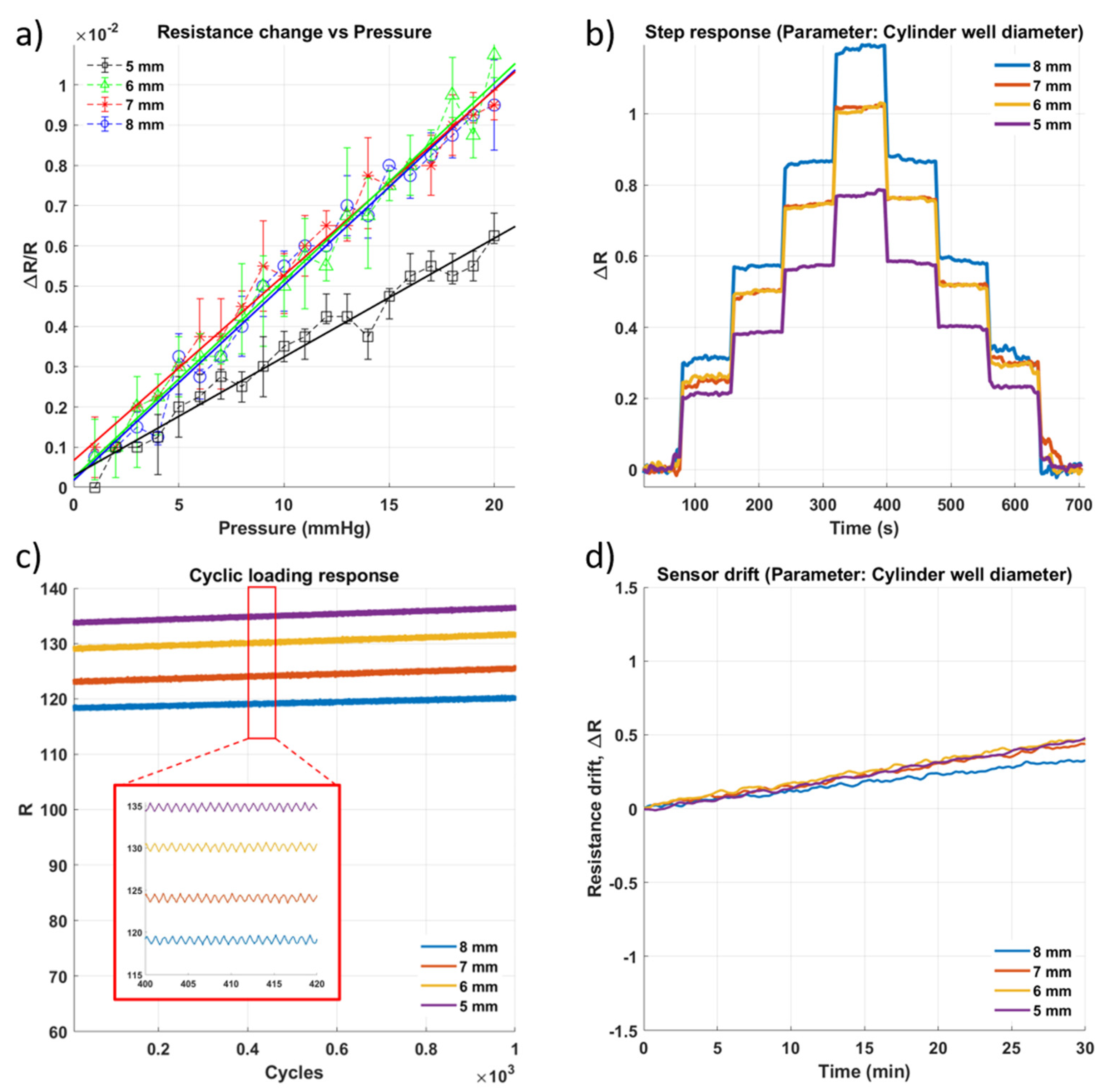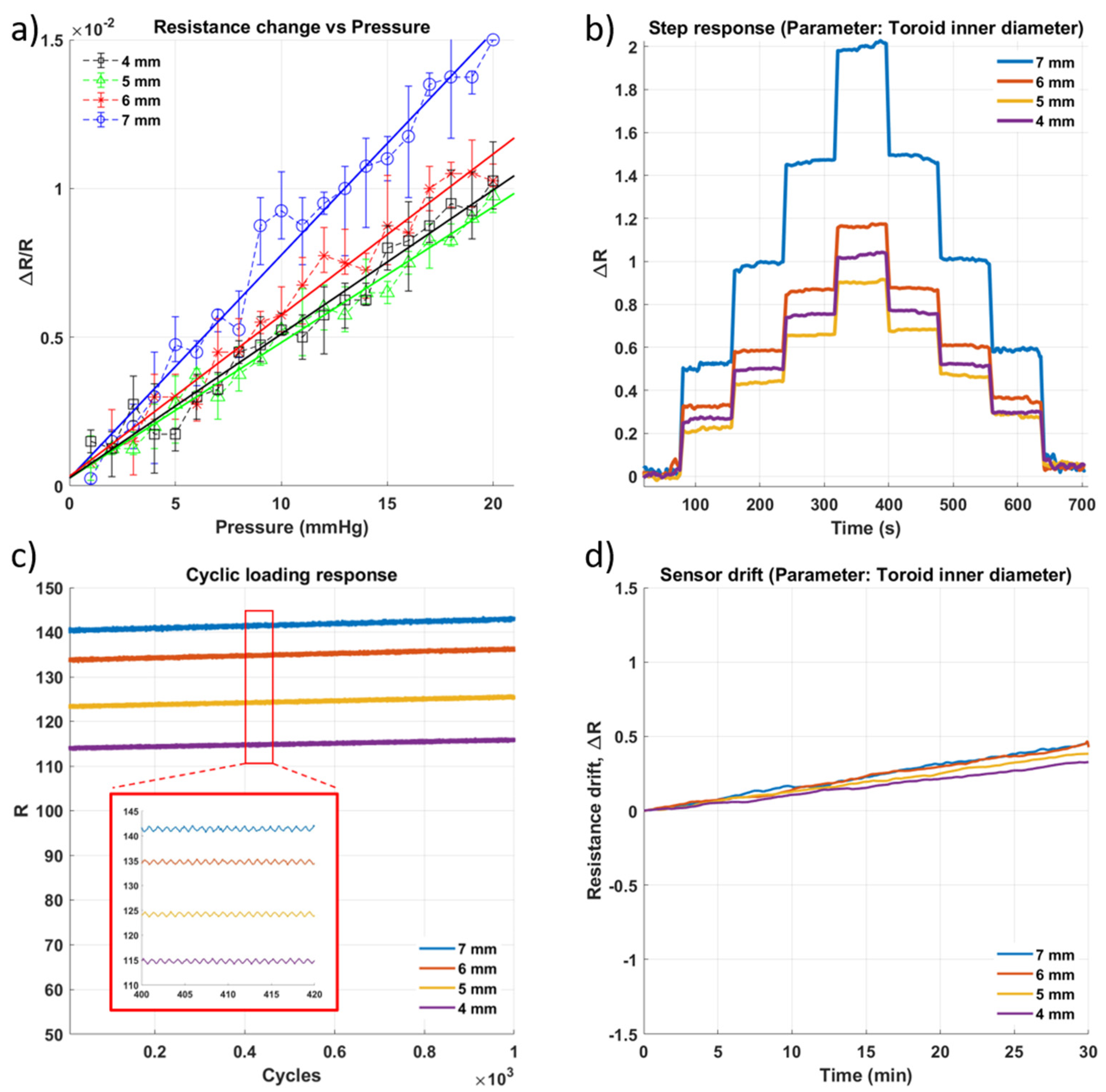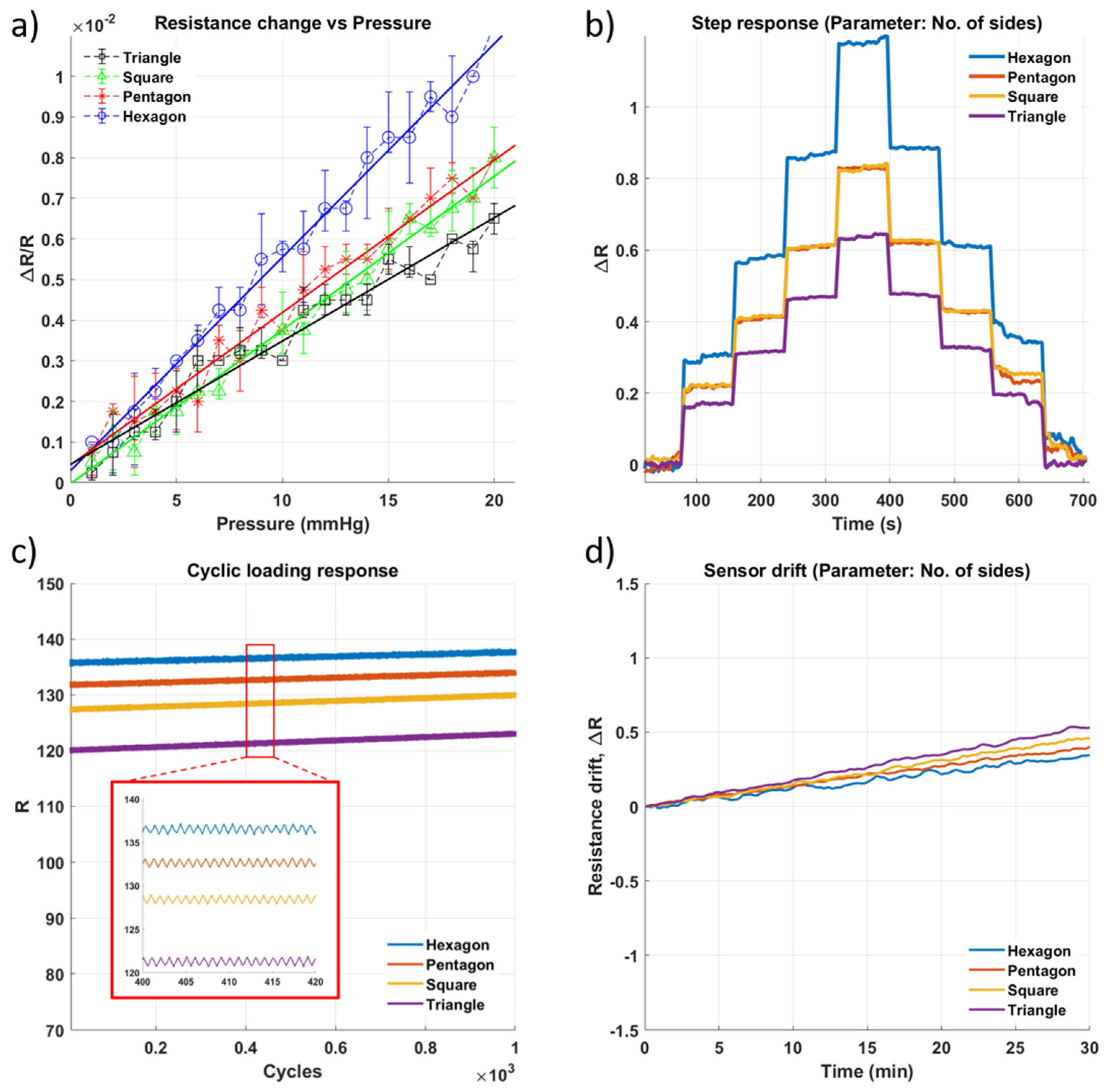Soft Ionic Pressure Sensor with Aloe Vera Gel for Low-Pressure Applications
Abstract
:1. Introduction
2. Related Work
3. Materials and Methods
4. Results and Discussion
4.1. Comparison between AgNW and Aloe Sensor
4.2. Characterization Experiments for Parameter Optimization
4.2.1. Varying Viscosity and Composition of Sensing Gel
4.2.2. Varying Geometrical Dimensions of the Sensing Channel
5. Conclusions
Author Contributions
Funding
Data Availability Statement
Conflicts of Interest
References
- Li, R.; Zhou, Q.; Bi, Y.; Cao, S.; Xia, X.; Yang, A.; Li, S.; Xiao, X. Research Progress of Flexible Capacitive Pressure Sensor for Sensitivity Enhancement Approaches. Sens. Actuators A Phys. 2021, 321, 112425. [Google Scholar] [CrossRef]
- Jena, S.; Gupta, A. Review on Pressure Sensors: A Perspective from Mechanical to Micro-Electro-Mechanical Systems. Sens. Rev. 2021, 41, 320–329. [Google Scholar] [CrossRef]
- Zhang, S.; Li, S.; Xia, Z.; Cai, K. A Review of Electronic Skin: Soft Electronics and Sensors for Human Health. J. Mater. Chem. B 2020, 8, 852–862. [Google Scholar] [CrossRef]
- Dunn, L.T. Raised Intracranial Pressure. J. Neurol. Neurosurg. Psychiatry 2002, 73, i23–i27. [Google Scholar] [CrossRef] [Green Version]
- Symon, L.; Dorsch, N.W.C. Use of Long-Term Intracranial Pressure Measurement to Assess Hydrocephalic Patients Prior to Shunt Surgery. J. Neurosurg. 1975, 42, 258–273. [Google Scholar] [CrossRef]
- Wiegand, C.; Richards, P. Measurement of Intracranial Pressure in Children: A Critical Review of Current Methods. Dev. Med. Child Neurol. 2007, 49, 935–941. [Google Scholar] [CrossRef]
- Gao, Y.; Xu, M.; Yu, G.; Tan, J.; Xuan, F. Extrusion Printing of Carbon Nanotube-Coated Elastomer Fiber with Microstructures for Flexible Pressure Sensors. Sens. Actuators A Phys. 2019, 299, 111625. [Google Scholar] [CrossRef]
- Grundmann, O. Aloe Vera Gel Research Review. Nat. Med. J. 2012, 4, 1–14. [Google Scholar]
- Volkov, A.G.; Foster, J.C.; Jovanov, E.; Markin, V.S. Anisotropy and Nonlinear Properties of Electrochemical Circuits in Leaves of Aloe Vera L. Bioelectrochemistry 2011, 81, 4–9. [Google Scholar] [CrossRef]
- Saberian, H.; Esfahani, Z.H.; Banakar, A. Ohmic Heating of Aloe Vera Gel: Electrical Conductivity and Energy Efficiency. Iran. J. Chem. Chem. Eng. 2018, 37, 157–165. [Google Scholar] [CrossRef]
- Souguir, D.; Abd-Alla, H.I.; El Ferjani, E.; Larbi Khouja, M.; Hachicha, M. Aloe Vera Long-Term Saline Irrigation Increases Contents of Hydrogen Peroxide, Lipid Peroxidation and Phenolic Compounds. Acta Agric. Scand. Sect. B—Soil Plant Sci. 2015, 65, 688–696. [Google Scholar] [CrossRef]
- Yamada, S.; Toshiyoshi, H. Temperature Sensor with a Water-Dissolvable Ionic Gel for Ionic Skin. ACS Appl. Mater. Interfaces 2020, 12, 36449–36457. [Google Scholar] [CrossRef]
- Zhang, S.; Wang, F.; Peng, H.; Yan, J.; Pan, G. Flexible Highly Sensitive Pressure Sensor Based on Ionic Liquid Gel Film. ACS Omega 2018, 3, 3014–3021. [Google Scholar] [CrossRef] [Green Version]
- Huang, Y.-C.; Liu, Y.; Ma, C.; Cheng, H.-C.; He, Q.; Wu, H.; Wang, C.; Lin, C.-Y.; Huang, Y.; Duan, X. Sensitive Pressure Sensors Based on Conductive Microstructured Air-Gap Gates and Two-Dimensional Semiconductor Transistors. Nat. Electron. 2020, 3, 59–69. [Google Scholar] [CrossRef]
- Chen, T.; Saadatnia, Z.; Kim, J.; Looi, T.; Drake, J.; Diller, E.; Naguib, H.E. Novel, Flexible, and Ultrathin Pressure Feedback Sensor for Miniaturized Intraventricular Neurosurgery Robotic Tools. IEEE Trans. Ind. Electron. 2021, 68, 4415–4425. [Google Scholar] [CrossRef]
- Sattayasoonthorn, P.; Suthakorn, J.; Chamnanvej, S. On the Feasibility of a Liquid Crystal Polymer Pressure Sensor for Intracranial Pressure Measurement. Biomed. Eng. Biomed. Tech. 2019, 64, 543–553. [Google Scholar] [CrossRef]
- JK O′Neill, S.; Gong, H.; Matsuhisa, N.; Chen, S.; Moon, H.; Wu, H.; Chen, X.; Chen, X.; Bao, Z. A Carbon Flower Based Flexible Pressure Sensor Made from Large-Area Coating. Adv. Mater. Interfaces 2020, 7, 2000875. [Google Scholar] [CrossRef]
- Qin, Z.; Sun, X.; Yu, Q.; Zhang, H.; Wu, X.; Yao, M.; Liu, W.; Yao, F.; Li, J. Carbon Nanotubes/Hydrophobically Associated Hydrogels as Ultrastretchable, Highly Sensitive, Stable Strain, and Pressure Sensors. ACS Appl. Mater. Interfaces 2020, 12, 4944–4953. [Google Scholar] [CrossRef]
- Lee, S.; Reuveny, A.; Reeder, J.; Lee, S.; Jin, H.; Liu, Q.; Yokota, T.; Sekitani, T.; Isoyama, T.; Abe, Y.; et al. A Transparent Bending-Insensitive Pressure Sensor. Nat. Nanotechnol. 2016, 11, 472–478. [Google Scholar] [CrossRef]
- Mao, Y.; Ji, B.; Chen, G.; Hao, C.; Zhou, B.; Tian, Y. Robust and Wearable Pressure Sensor Assembled from AgNW-Coated PDMS Micropillar Sheets with High Sensitivity and Wide Detection Range. ACS Appl. Nano Mater. 2019, 2, 3196–3205. [Google Scholar] [CrossRef]
- de Oliveira, J.G.; Muhammad, T.; Kim, S. A Silver Nanowire-Based Flexible Pressure Sensor to Measure the Non-Nutritive Sucking Power of Neonates. Micro. Nano. Syst. Lett. 2020, 8, 18. [Google Scholar] [CrossRef]
- Russo, S.; Ranzani, T.; Liu, H.; Nefti-Meziani, S.; Althoefer, K.; Menciassi, A. Soft and Stretchable Sensor Using Biocompatible Electrodes and Liquid for Medical Applications. Soft Robot. 2015, 2, 146–154. [Google Scholar] [CrossRef] [Green Version]
- Cheung, Y.-N.; Zhu, Y.; Cheng, C.-H.; Chao, C.; Leung, W.W.-F. A Novel Fluidic Strain Sensor for Large Strain Measurement. Sens. Actuators A Phys. 2008, 147, 401–408. [Google Scholar] [CrossRef]
- Choi, D.Y.; Kim, M.H.; Oh, Y.S.; Jung, S.-H.; Jung, J.H.; Sung, H.J.; Lee, H.W.; Lee, H.M. Highly Stretchable, Hysteresis-Free Ionic Liquid-Based Strain Sensor for Precise Human Motion Monitoring. ACS Appl. Mater. Interfaces 2017, 9, 1770–1780. [Google Scholar] [CrossRef]
- Ying, B.; Wu, Q.; Li, J.; Liu, X. An Ambient-Stable and Stretchable Ionic Skin with Multimodal Sensation. Mater. Horiz. 2020, 7, 477–488. [Google Scholar] [CrossRef]
- Dagdeviren, C.; Javid, F.; Joe, P.; von Erlach, T.; Bensel, T.; Wei, Z.; Saxton, S.; Cleveland, C.; Booth, L.; McDonnell, S.; et al. Flexible Piezoelectric Devices for Gastrointestinal Motility Sensing. Nat. Biomed. Eng. 2017, 1, 807–817. [Google Scholar] [CrossRef] [PubMed]
- Dai, G.; Wang, L.; Cheng, S.; Chen, Y.; Liu, X.; Deng, L.; Zhong, H. Perovskite Quantum Dots Based Optical Fabry–Pérot Pressure Sensor. ACS Photonics 2020, 7, 2390–2394. [Google Scholar] [CrossRef]
- Jiang, H.; Woodhouse, I.; Selvamani, V.; Ma, J.L.; Tang, R.; Goergen, C.J.; Soleimani, T.; Rahimi, R. A Wireless Implantable Passive Intra-Abdominal Pressure Sensing Scheme via Ultrasonic Imaging of a Microfluidic Device. IEEE Trans. Biomed. Eng. 2021, 68, 747–758. [Google Scholar] [CrossRef]
- Velez, A.R.; Mufari, J.R.; Rovetto, L.J. Sodium Salts Solubility in Ternary Glycerol+water+alcohol Mixtures Present in Purification Process of Crude Glycerol from the Biodiesel Industry. Fluid Phase Equilibria 2019, 497, 55–63. [Google Scholar] [CrossRef]
- Ying, B.; Liu, X. Skin-like Hydrogel Devices for Wearable Sensing, Soft Robotics and Beyond. iScience 2021, 24, 103174. [Google Scholar] [CrossRef]







| Design Parameter | Parametric Value and Sensitivity | |||
|---|---|---|---|---|
| Glycerin concentration | 80% | 60% | 40% | 20% |
| 2.335 | 3.083 | 4.374 | 3.350 | |
| Cylinder well diameter | 8 mm | 7 mm | 6 mm | 5 mm |
| 4.857 | 4.602 | 4.300 | 2.949 | |
| Inner diameter of the ring | 7 mm | 6 mm | 5 mm | 4 mm |
| 4.976 | 4.938 | 4.273 | 4.043 | |
| Inner diameter of the Torus | 7 mm | 6 mm | 5 mm | 4 mm |
| 7.498 | 5.415 | 4.556 | 4.838 | |
| Polygon shape | Hexagon | Pentagon | Square | Triangle |
| 5.254 | 3.748 | 3.782 | 3.036 | |
Publisher’s Note: MDPI stays neutral with regard to jurisdictional claims in published maps and institutional affiliations. |
© 2022 by the authors. Licensee MDPI, Basel, Switzerland. This article is an open access article distributed under the terms and conditions of the Creative Commons Attribution (CC BY) license (https://creativecommons.org/licenses/by/4.0/).
Share and Cite
Sujeesh, V.; Ponraj, G.; Ren, H. Soft Ionic Pressure Sensor with Aloe Vera Gel for Low-Pressure Applications. Micromachines 2022, 13, 146. https://doi.org/10.3390/mi13020146
Sujeesh V, Ponraj G, Ren H. Soft Ionic Pressure Sensor with Aloe Vera Gel for Low-Pressure Applications. Micromachines. 2022; 13(2):146. https://doi.org/10.3390/mi13020146
Chicago/Turabian StyleSujeesh, Vishnu, Godwin Ponraj, and Hongliang Ren. 2022. "Soft Ionic Pressure Sensor with Aloe Vera Gel for Low-Pressure Applications" Micromachines 13, no. 2: 146. https://doi.org/10.3390/mi13020146
APA StyleSujeesh, V., Ponraj, G., & Ren, H. (2022). Soft Ionic Pressure Sensor with Aloe Vera Gel for Low-Pressure Applications. Micromachines, 13(2), 146. https://doi.org/10.3390/mi13020146







